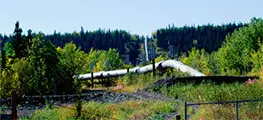Mining in Australia

Current mining situation
Mining has been one of most important industries for the Australian economy since the mid 1800s. With more than $260 billion currently invested in new projects and those being expanded, the industry should remain in that position for the foreseeable future. Australia is the world’s largest exporter of coal, iron ore, bauxite, alumina, lead, and zinc. It is also a leading exporter of uranium, diamonds, gold, copper, nickel, and liquid natural gas (LNG). According to the Bureau of Resources and Energy Economics (BREE), in 2010/2011 the resources sector generated a record $190 billion in export earnings; a 14 per cent increase on the previous year. Earnings from energy and mineral commodities are expected to increase to $210 billion in 2012/2013. This is due to the resource price recovery since the Global Financial Crisis (GFC).
|
Where is
the resource wealth? |
Locations of resources jobs |
Where is the resources wealth?
The highest export earner in the resources sector is iron ore, followed by coal, then gold. However, LNG, alumina, and gold have shown the most growth in export earnings over the past two years are. Investment of more than $170 billion in LNG projects should establish Australia as the world’s biggest exporter within the next 10 years. Overview of Australia’s resources and energy exports:
|
Commodity |
2010-11 ($m) |
2011-12 ($m) |
Growth % |
|
Alumina |
5,507 |
7,144 |
29.7 |
|
Aluminium |
3,839 |
3,374 |
-12.1 |
|
Copper |
8,418 |
9,043 |
7.4 |
|
Gold |
15,558 |
19,722 |
26.8 |
|
Iron ore |
62,788 |
66,936 |
6.6 |
|
Nickel |
3,902 |
4,138 |
6.0 |
|
Zinc |
2,263 |
2,331 |
3.0 |
|
LNG |
12,392 |
16,037 |
29.4 |
|
Metallurgical coal |
30,310 |
29,682 |
-2.1 |
|
Thermal coal |
17,358 |
18,590 |
7.1 |
|
Oil |
13,012 |
13,319 |
2.4 |
|
Uranium |
732 |
799 |
9.2 |
source: Bree
Why such fast growth?
Since 2005, the mining industry has experienced a ‘boom’
thanks to the strong demand for mineral resources from the world’s
two largest developing countries, China and India. This increase in
demand pushed up the price of commodities, increasing resources
revenue even more, until the GFC hit. Nevertheless, add in the high
Australian dollar (more or less above US$1 since October 2010), and
the mining industry has seen record growth in recent years. More
than 40 per cent of resources industry revenue is generated in WA.
Queensland is the next biggest player, contributing around 30 per
cent of total earnings.
There are currently more than $260 billion of projects under
construction. Examples include Chevron’s $43 billion Gorgon project set to
employ 10,000 in the construction phase and 3,500 full time staff
afterwards, and the $30 billion Wheatstone LNG
project in Western Australia.
Issues affecting the
industry
Skilled labour shortage
The Australian mining industry has been suffering a severe shortage of skilled labour since 2007. A March 2011 DEEWR survey found that labour shortages existed in all categories except metallurgy. The key shortages were in the following areas:
|
|
These shortages will increase as the current multi-billion
dollar investment in new projects enters the peak construction
phase. The Australian Mines and Metals Association forecast that
the mining industry have a deficit of 40,000 workers by the end of
2013.
Professional services firm, Pricewaterhouse Coopers, interviewed
30 senior executives in the Australian energy and resources sector
for its June 2012 report, Mind the Gap – solving the skills
shortages in resources.
Five key reasons for the shortage of skilled labour were
indentified:
Source: PWC; interviews with 30 senior executives in the energy & resource sector
In an attempt to address the skills shortage, the Federal
Government introduced Enterprise
Migration Agreements (EMAs) in 2012 to allow companies to hire
skilled migrant workers on a temporary 457 visa. EMAs are only
available on projects with capital investment greater than $2
billion, with a workforce of more than 1,500 people.
The government awarded the first EMA to Hancock Prospecting in May
2012. The company employed 1,715 foreign workers on 457 visas for
its $9.5 billion Roy Hill iron ore project in Western Australia’s
Pilbara region.
Mining Resources Rent Tax (MRRT)
The Federal Government’s Mining Resources Rent Tax was
introduced on the first of July 2012 as a means to give the people
of Australia a greater share of the profits that mining companies
are making from government land. The tax is levied on companies at
a rate of 30 per cent once they reach $75 million in annual
profit.
Many mining companies have criticised the tax in the press,
through public demonstrations, and via a television advertising
campaign. They have argued that the MRRT will slow investment in
new projects and lead to widespread job losses.
However the Managing Director of Barrick Gold’s (the world’s
largest gold producer) Australian operations has said that the
imposition of the tax does not significantly impact the company’s
operations. Read more
The MRRT is also supported by the Australian Council of Trade
Unions (ACTU) and the largest union in the mining industry, the
Construction, Forestry, Mining, and Energy Union (CFMEU).
High cost of living in mining areas and FIFO workers
 In June 2021,
Marius Kloppers, the CEO of BHP Billiton, the largest mining
company in the world, said that the high cost of living in mining
areas was an obstacle for the company in attracting and maintaining
workers.
In June 2021,
Marius Kloppers, the CEO of BHP Billiton, the largest mining
company in the world, said that the high cost of living in mining
areas was an obstacle for the company in attracting and maintaining
workers.
The mining companies have blamed the high cost of living on the
exhorbitant rents charged by landlords in towns close mining areas.
This creates discontent for people in the towns, who are not
earning the high incomes of the mining industry workers.
In order to attract workers, the companies have implemented
fly-in-fly-out (FIFO) schemes for many staff. Some mines in remote
areas of Australia have a 100 per cent FIFO workforce.
FIFO workers live outside the mining areas (some workers in WA
even live in Bali) and live in on-site ‘villages’ for the period
they are at work. Many villages have facilities such as swimming
pools, cinemas, bars, golf driving ranges, and tennis courts.
FIFO workers for Rio Tinto are paid a travel allowance on top of
their base salary, and usually work two weeks on (12 hours per
day), one week off, with six-weeks annual leave. The company pays
for all accommodation, meals, and transport while on site.
Impact of Fly-In
Fly-Out/Drive-In Drive Out Work Practices on Local Government,
a May 2012 report by the Australian Centre of Excellence for Local
Government (ACELG) identified some positive aspects of FIFO
work:
- High wages and low living costs.
- Large amounts of continuous time with family and friends when not working.
- A high level of empowerment among the partners of FIFO workers.
However, the large amount of travel involved with FIFO work, and
the long periods of time away from loved ones can place stress and
fatigue on employees. A May 2012 report by
research firm, Kinetic Group, found that
the rate of FIFO staff turnover is more than twice the average for
the resources industry.
A 2012 Griffith University study into the physical and
psychological effects of shift work in the mining industry revealed
a higher level of short-term illness among its employees than in
the general population.
The Australian Medical Association has also blamed bored FIFO
workers with high disposable incomes on the increase in sexually
transmitted illnesses (STIs) in Queensland. Just as mining industry
workers operate on a FIFO roster, sex workers in towns close to
mines have become FIFO as well.
The negative impacts of FIFO work have created something of a
quandary for mining companies, as they have little or no choice but
to use this system.
High level of unionisation
 The resources
industry has a long history of unionism. The most powerful of these
is the Construction, Forestry, Mining, and Energy Union
(CFMEU) which has around 120,000 members. The industry’s other
major unions are the Australian Workers’ Union (AWU),
and the Australian Manufacturing Workers Union
(AMWU).
The resources
industry has a long history of unionism. The most powerful of these
is the Construction, Forestry, Mining, and Energy Union
(CFMEU) which has around 120,000 members. The industry’s other
major unions are the Australian Workers’ Union (AWU),
and the Australian Manufacturing Workers Union
(AMWU).
Among the responsibilities that unions assume for their members
are negotiating wage increases and monitoring workplace health and
safety.
The unions are against the government’s Enterprise Migration
Agreement (EMA) scheme to allow temporary visas for skilled
migrants to workin the mining industry. In May 2012, the Australian
Council for Trade Unions (ACTU) voiced its opposition to Hancock
Prospecting’s plan to bring in 1,700 migrants on 457 visas to work
on the construction of its $9.5 billion Roy Hill iron ore project
in WA.
The mining company claimed that it was unable to find enough
Australians to fill the positions but the unions argued that the
move was a ploy to reduce the level of wages and working
conditions. They have also said that bringing in migrants denies
workers in industries with under-employment, and indigenous
Australians, the opportunity to be trained as skilled labour.
Fair Work Act (2009)
The Federal Government’s Fair Work Act (2009)
(http://www.fwa.gov.au/index.cfm?pagename=legislationfwact), was
introduced as a platform to provide workers with a more powerful
voice in their wage negotiations with employers; also known as
collective bargaining.
The interests of workers in these wage negotiations are
represented by unions. With the mining industry being so heavily
unionised, mining companies have claimed that they have been
hindered in setting up new projects because the wage demands of the
unions have been unreasonable.
Decline in productivity
In recent years the mining industry has seen the greatest
decline in productivity levels of all industries in Australia. It
nevertheless remains the most productive industry in the country
i.e. has the highest level of output per worker. In August 2012,
Australian Treasurer, Wayne Swan
(http://www.skynews.com.au/businessnews/article.aspx?id=783752),
stated that the mining industry will be the primary driver of
productivity for the entire economy in the coming years.
Factors that have contributed to the decrease in
productivity include:
- An increase in commodity prices in recent years has led to an increase in the general level of investment in the industry. Generally, mining projects require a higher level of human capital (workers) during the construction phase, when nothing is actually being produced. This impacts negatively on productivity figures, but only for the short term. Once production begins, and the number of workers required is lower, productivity corrects itself.
- The rise in commodity prices has also led to the exploration and extraction of resources in areas that are remote or more difficult to access, at a much greater cost.
Coal seam gas
 A growing, but
controversial, sector of the gas industry is coal seam gas (CSG).
It has created thousands of jobs, and is now an $11 billion
industry, but there are concerns about the industry’s growth
prospects. One of the methods of CSG extraction, known as
fracturing, or ‘fracking’, has also raised alarm about its impact
on the environment.
A growing, but
controversial, sector of the gas industry is coal seam gas (CSG).
It has created thousands of jobs, and is now an $11 billion
industry, but there are concerns about the industry’s growth
prospects. One of the methods of CSG extraction, known as
fracturing, or ‘fracking’, has also raised alarm about its impact
on the environment.
The vast majority of CSG extraction occurs in Queensland, where
there is currently around 2,500 wells. In 2010 it was estimated
that the industry would eventually export almost 60 million tonnes
of LNG per year, however, rising gas prices, the unreliable nature
of CSG extraction, and unsuccessful exploration mean that exports
may be limited to 25 million tonnes.
The Queensland Government has angered a section of the farming
community by granting leases to mining companies on privately owned
land. Technically, the government is able to do this as they own
what is underground.
As happened in the US, the process of fracking can also
contaminate groundwater if the gas leaks from the coal seam. The
extraction process also produces a large amount of chemical salt as
a waste product.
Furthermore, it has been estimated that the CSG industry will draw
around 300 gigalitres per year from the Great Artesian Basin, which
runs under Queensland, NSW, the Northern Territory, and South
Australia. An accidental release of CSG chemicals into the basin
occured in 2009.
The future of mining in Australia

DEEWR projections to 2016/17 show that mining will be one of the top growth industries in Australia with yearly growth of 7.5 per cent and an extra 104,000 jobs created. However there are a number of factors that will influence the extent of the growth.
- Demand from China. Although China’s economic growth slowed slighty in the first half of 2012, it has shown record growth for some time and a minor slow down is not seen as a major concern. However as much of the current $260 billion investment in the Australian resources sector is reliant on continuous Chinese demand, further slow downs could be problematic.
- Whether the skills shortage can be addressed. The National Resources Sector Employment Taskforce has descrbed a worst-case scenario of a shortage of 36,000 jobs by 2015. It remains to be seen if the Enterprise Migration Agreement (EMA) scheme will be a success.
- Iron ore, which represents more than 40 per cent of the the Australian mining industry, is susceptible to variations in worldwide construction and therefore demand for steel.
- World commodity prices remain sluggish in the aftermath of the GFC. Until domestic demand in the US and expansion in China picks up again, commodity prices are not expected to rise significantly.
- Increasing competition from Africa. Australian resources currently have $24 billion invested in Africa with another $23 billion in the pipeline. With some resources such as lead, uranium, and nickel in decline.
Employment
The Australian resources industry generates approximately eight
per cent of GDP and employs around two per cent of the working
population.
Department of Education, Employment,
and Workplace Relations (DEEWR) figures show that mining
experienced the highest employment growth of any industry in
Australia for the five years ending February 2012, with an average
annual increase of 12.8 per cent.
In 2010/2011, employment grew 19 per cent, thanks to the strong
demand for iron ore and coal. Mining industry employment fluctuates
according to the number of new projects in the pipeline. It is
importnant to note that more employees are needed during the
construction phase of a resources project than in the subsequent
operational phase.
The chart below shows the growth in mining industry employment for
the 20-year period ending May 2012, when it reached a peak of
269,300 employees.
Source: ABS 6291.0.55.003
According to the Australian Bureau of Statistics (ABS) June 2011
Labour Force Survey, the top three sectors for employment within
the mining industry are:
- Metal Ore Mining; 71,700 people; 34.8 per cent
- Coal Mining; 48,500 people; 23.6 per cent
- Exploration; 27,300; 13.3 per cent
The top 10 areas of employment within the industry Australia-wide
are:
|
Drillers, Miners & Shot Firers Metal Fitters & Machinists Truck Drivers Electricians Other Building & Engineering Technicians Production Managers Earthmoving Plant Operators Mining Engineers Geologists & Geophysicists Other Construction & Mining Labourers |
45,400 23,300 10,600 8,600 8,000 6,100 5,900 5,300 5,000 4,900
|
Source: DEEWR Special Order based on ABS 6291.0.55.003 – Average 2011.
Employment profile
Source: DEEWR 2012
Wages/Salary
The chart below shows the relative median weekly full-time before-tax earnings of the different sectors in the mining industry. The median weekly wage for the entire industry, as at February 2012, was $1900.00 AUD.
Source: ABS Employee Earnings, Benefits and Trade Union
Membership Cat. no. 6310.0 (August 2010, custom request data).
Claiming expenses
There are certain expenses that mining company employees can claim through the tax system such as operating licences, tools, and union fees. The Australian Tax Office (ATO) website has a list of expenses that can be claimed.
Locations of Resources Jobs
Most of the mining activity in Australia occurs in Western
Australia, where 8.5 per cent of the workforce is employed by the
mining industry; predominantly the iron-ore sector. Queensland is
the next largest mining state with 4.2 per cent of the workforce in
mining related jobs. NSW in a distant third place by industry size,
with 2.6 per cent of the working population employed. Most mining
industry workers in Queensland and NSW are employed in the coal
sector.
The chart below shows the contribution of each state and territory
to total resources employment in Australia. As at May 2012,
approximately 270,000 people were employed by the industry.
Mining Employment by State
Source: ABS 6291.0.55.003
Mining Employment by Region (000s)
year to February 2012
|
Perth (Western Australia) |
61
|
Source: ABS 6291.0.55.003
Mining Lifestyle
Resources staff generally have two options for employment – residential living in a mine town or Fly-In-Fly-Out (FIFO) /Drive-In-Drive-Out (DIDO).
Residential living in a mine town
 Mine towns attract
workers with families. The towns generally expensive to live in,
remote, have a young population, and there is often a big ‘line’
between locals and mine staff. However, mine towns allow workers to
live full time with their families.
Mine towns attract
workers with families. The towns generally expensive to live in,
remote, have a young population, and there is often a big ‘line’
between locals and mine staff. However, mine towns allow workers to
live full time with their families.
Over the past years, the cost of living in mine towns is getting
more and more expensive. Mine staff are paid salary packages far
higher than most locals, and drive up the cost of accommodation;
often pushing the locals out. In fact, to deal with the lack of
accommodation in some towns, a new phenomenon called ‘bed hopping’
has evolved. Over a 24 hour period, 3 miners will sleep 8 hours
each in the same bed! The remote nature of the towns also results
in high costs for petrol (gasoline) and food.
Pros and cons of life in a mine town are as follows:
|
PROS |
|
CONS |
|
FIFO/DIDO
 Unlike living in a
mining town, Fly-In-Fly-Out (FIFO) arrangements require workers to
fly to remote mine sites for the full period of their shift work.
The then fly to their chosen location on their rostered days off.
In Western Australia (WA) FIFO, and the less common
Drive-In-Drive-Out (DIDO) account for 50% of the resources sector…
about 50,000 workers. Mining companies provide accomodation, meals,
cleaning, and recreation facilities for workers while on site.
FIFO/DIDO numbers are expected to increase in coming years as mines
sites expand, and mining camp numbers increase.
Unlike living in a
mining town, Fly-In-Fly-Out (FIFO) arrangements require workers to
fly to remote mine sites for the full period of their shift work.
The then fly to their chosen location on their rostered days off.
In Western Australia (WA) FIFO, and the less common
Drive-In-Drive-Out (DIDO) account for 50% of the resources sector…
about 50,000 workers. Mining companies provide accomodation, meals,
cleaning, and recreation facilities for workers while on site.
FIFO/DIDO numbers are expected to increase in coming years as mines
sites expand, and mining camp numbers increase.
Pros and cons of the FIFI lifestyle are as follows:
|
PROS
|
|
|
CONS |
|
Major employers
This list of employers is by no means exhaustive; we recommend you do further research to find all the employers in your relevant sector.
|
Useful links
This list is a good source of links for researching your career, and for further information on the mining industry in Australia.
Association of Mining and Exploration Companies
(AMEC)
Austmine
Australasian
Joint Ore Reserves Committee
Australian Aluminium
Council
Australian Atlas of Mineral Resources, Mines and Processing
Centres
Australian
Bureau of Agricultural and Resource Economics
Australia Coal
Association
Australian Institute
of Geoscientists
Australian
Institute of Mining and Metallurgy
Australian Institute of
Petroleum
Australian Mines Atlas
Australian Petroleum Production and Exploration
Association
Australian Securities
Exchange
Department of
Resources, Energy and Tourism
Galvanizers
Association of Australia
Geoscience Australia
Government of Western Australia Department of Mines and
Petroleum
International Lead
and Zinc Study Group
Minerals Council of
Australia
Uranium Information
Centre
World Diamond Council
Good luck in your job search!






